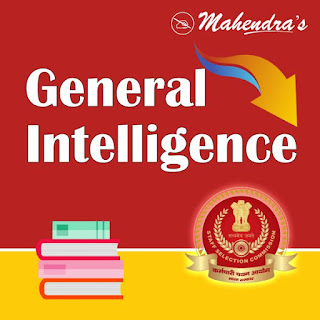Dear Readers,
As SSC CPO notification is out and candidates have started their preparation for this exam. Mahendras also has started special quizzes for this examination. This series of quizzes are based on the latest pattern of the SSC CPO examination. Regular practice of the questions included in the quizzes will boost up your preparations and it will be very helpful in scoring good marks in the examination.
Q.1 From the given Answer Figures select the one in which the Question Figure is hidden/embedded. (Rotation is not allowed)
दिए गए उत्तर आकृतियों में से वह प्रश्न आकृति चुनें जिसमें प्रश्न आकृति छिपी / सन्निहित है। (रोटेशन की अनुमति नहीं है)
Q.2 How many triangles are there in the following figure?
निम्नलिखित आकृति में कितने त्रिभुज हैं?
1. 18
2. 21
3. 22
4. 19
Q.3 If in a language, 'foot’ is called 'elbow', 'elbow' is called ‘ankle', 'ankle' is called “palm, 'palm’ is called 'finger’ and 'finger' is called ‘knee', then in that language, on what would one wear a shoes?
A. Ankle
B. Knee
C. Elbow
D. Finger
यदि किसी भाषा में 'पैर’ को 'कोहनी ', 'कोहनी ' को ‘टखने', 'टखने' को “हथेली, 'हथेली’ को 'उंगली’ और 'उंगली' को ‘घुटना’ कहा जाता है, तो उसी भाषा में, कोई किसमें जूते पहनेगा?
A. टखने
B. घुटने
C. कोहनी
D. अंगुली
Q.4 Three of the following four numbers-pairs are alike in a certain way and one is different. Identify the different one.
निम्नलिखित चार संख्याओं में से तीन-जोड़े एक निश्चित तरीके से समान हैं और एक अलग है। उस अलग को पहचानें।
A. Keep : 4
B. Superb : 6
C. Singer : 7
D. Filter : 6
Q.5. The sequence of folding a piece of square paper and the manner in which the folded paper has been cut is shown. How would this paper look when unfolded?
वर्गाकार कागज के टुकड़े को मोड़ने और फिर उस मुड़े हुए कागज को काटने का क्रम नीचे दिखाया गया है। जब इस कागज को खोला जायेगा तो यह कैसा दिखेगा?
A. 2
B. 1
C. 4
D. 3
Q.6. Two statements are given, followed by two conclusions I and II Assuming these statements to be true, even if they seem to be at variance with commonly known facts, decide which of the given conclusions logically follow(s) from the statements.
Statements:
No Tablet is lion.
All lions are bells.
Conclusions:
I. Some bells are not tablet.
II. Some bells are not lions.
A. Only conclusion I follows.
B. Both conclusions I and II follow.
C. Only conclusion II follows.
D. Neither conclusion I nor II follows.
दो कथन दिए गए हैं, इसके बाद दो निष्कर्ष I और II है। इन कथनों को सत्य माने हैं, भले ही वे सामान्यतः ज्ञात तथ्यों के साथ विचरण करते हों, फिर यह निर्णय ले कि दिए गए निष्कर्षों में से कौन-सा कथन से तार्किक रूप से अनुसरण करता है।
कथन:
कोई टैबलेट शेर नहीं है।
सभी शेर घंटियाँ हैं।
निष्कर्ष:
I. कुछ घंटियाँ टैबलेट नहीं हैं।
II. कुछ घंटियाँ शेर नहीं हैं।
A. केवल निष्कर्ष I अनुसरण करता है।
B. दोनों निष्कर्ष I और II अनुसरण करते हैं।
C. केवल निष्कर्ष II अनुसरण करता है।
D. न तो निष्कर्ष I और न ही II अनुसरण करता है।
Q.7 Which letter-cluster will replace the question mark (?) in the following series?
निम्नलिखित अक्षर- श्रृंखला में कौन-से अक्षर-समूह प्रश्न चिह्न (?) के स्थान पर आयेगें?
IVM, JWN, LYP, OBS, ?
A. PFV
B. TFW
C. PUW
D. PFW
Q.8 Which letter will replace the question mark (?) in the following series?
निम्नलिखित अक्षर- श्रृंखला में कौन-सा अक्षर प्रश्न चिह्न (?) के स्थान पर आयेगा?
LR, NV, PZ, RD, ?
A. OD
B. PD
C. NQ
D. RD
Q.9. If Federation = 114, Little = 41 and Highest = 69 then Group= ?
यदि Federation = 114, Little = 41 और Highest = 69 है तो Group= ?
A. 41
B. 55
C. 113
D. 68
Q.10 Select the number-pair in which the two numbers are related in the same way as are the two numbers of the given number pair.
उस संख्या-जोड़ी का चयन करें जिसमें दो संख्याएँ उसी तरह से संबंधित हैं जैसे कि दी गई संख्या जोड़ी की दो संख्याएँ हैं।
15 : 225
A. 17 : 306
B. 13 : 208
C. 11 : 242
D. 19 : 437
ANSWER-
Q.1. (D)
Q.2. (B)
Q.3. (C)
We wear the shoes in the foot and in the question foot is called the elbow.
हम पैर में जूते पहनते हैं और प्रश्न में पैर को कोहनी कहा जाता है।
Q.4. (C)
Keep has 4 letters, Superb has 6 letters and Filter has 6 letters but option C is incorrect.
Keep में 4 अक्षर है, Superb में 6 अक्षर है और Filter में 6 अक्षर हैं लेकिन विकल्प C गलत है।
Q.5. (A)
Q.6. (A)
Q.7. (D)
IVM (+1, +1, +1), JWN (+2, +2, -2), LYP (+3, +3, +3), OBS (+4, +4, +4), PFW
Q.8. (D)
LR (+2 +4), NV (+2 +4), PZ (+2 +4), RD
Q.9. (A)
Federation = 10 letters = 10 x 10 = 100 + (place value of last letter) = 100 + 14 = 114
Federation = 10 अक्षर = 10 x 10 = 100 + (अंतिम अक्षर का स्थानीयमान) = 100 + 14 = 114
Q.10. (D)
15 : 225 = 15 x (next prime number) = 15 x 17
19 : 437 = 19 x (next prime number) = 19 x 23
15: 225 = 15 x (अगली अभाज्य संख्या) = 15 x 17
19: 437 = 19 x (अगली अभाज्य संख्या) = 19 x 23






0 comments:
Post a Comment
MAHENDRA GURU